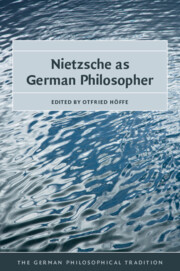Book contents
- Nietzsche as German Philosopher
- The German Philosophical Tradition
- Nietzsche as German Philosopher
- Copyright page
- Contents
- Contributors
- Source Acknowledgments
- Abbreviations
- Introduction
- I The Aesthetic Dimension
- II Philosophical Themes
- 5 Nietzsche’s Invention of the Pre-Socratics
- 6 Nietzsche’s Stance toward Ancient and Modern Enlightenment
- 7 “An Animal That May Make Promises” (GM II, 1–3)
- III Power and Truth
- IV Religion and Religiosity
- Bibliography
- Index
7 - “An Animal That May Make Promises” (GM II, 1–3)
from II - Philosophical Themes
Published online by Cambridge University Press: 18 February 2021
- Nietzsche as German Philosopher
- The German Philosophical Tradition
- Nietzsche as German Philosopher
- Copyright page
- Contents
- Contributors
- Source Acknowledgments
- Abbreviations
- Introduction
- I The Aesthetic Dimension
- II Philosophical Themes
- 5 Nietzsche’s Invention of the Pre-Socratics
- 6 Nietzsche’s Stance toward Ancient and Modern Enlightenment
- 7 “An Animal That May Make Promises” (GM II, 1–3)
- III Power and Truth
- IV Religion and Religiosity
- Bibliography
- Index
Summary
The electrifying opening question in the second essay of Nietzsche’s On the Genealogy of Morals can be read as an aphorism as it is defined in the preface, namely, as something that requires creative deciphering. For it contains hooks and snares in which a merely superficial reading quickly becomes entangled. Furthermore, one would like to perceive its connection with the first treatise, with its oppositions of Good–Bad and Good–Evil, or between the master morality and slave morality.
- Type
- Chapter
- Information
- Nietzsche as German Philosopher , pp. 139 - 152Publisher: Cambridge University PressPrint publication year: 2021

